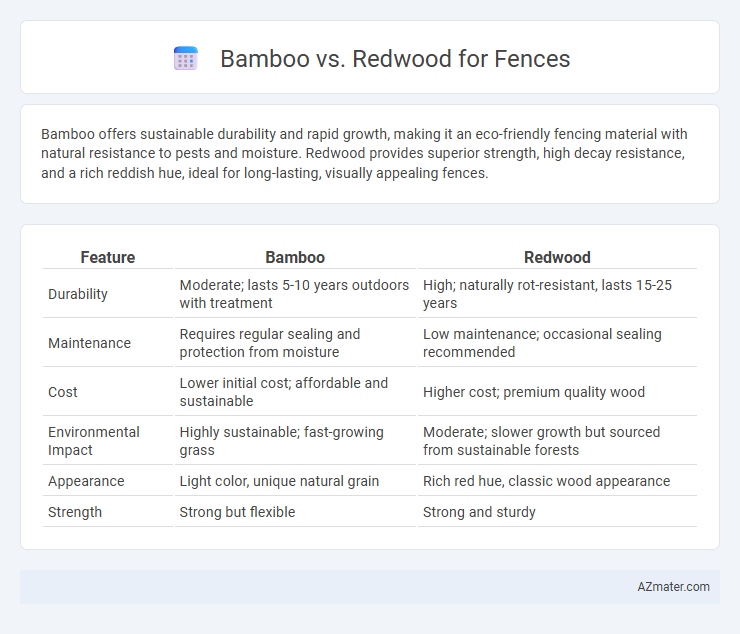Bamboo offers sustainable durability and rapid growth, making it an eco-friendly fencing material with natural resistance to pests and moisture. Redwood provides superior strength, high decay resistance, and a rich reddish hue, ideal for long-lasting, visually appealing fences.
Table of Comparison
| Feature | Bamboo | Redwood |
|---|---|---|
| Durability | Moderate; lasts 5-10 years outdoors with treatment | High; naturally rot-resistant, lasts 15-25 years |
| Maintenance | Requires regular sealing and protection from moisture | Low maintenance; occasional sealing recommended |
| Cost | Lower initial cost; affordable and sustainable | Higher cost; premium quality wood |
| Environmental Impact | Highly sustainable; fast-growing grass | Moderate; slower growth but sourced from sustainable forests |
| Appearance | Light color, unique natural grain | Rich red hue, classic wood appearance |
| Strength | Strong but flexible | Strong and sturdy |
Introduction: Comparing Bamboo and Redwood Fencing
Bamboo and redwood are popular choices for durable and aesthetically pleasing fencing materials, each offering unique benefits for outdoor spaces. Bamboo fencing provides eco-friendly sustainability, fast growth cycles, and natural resistance to pests and moisture, making it ideal for environmentally conscious homeowners. Redwood fencing is renowned for its strength, resistance to decay, and rich reddish hue, delivering long-lasting performance and classic beauty in garden and yard enclosures.
Material Overview: Bamboo vs Redwood
Bamboo offers a lightweight, eco-friendly fencing option known for its rapid growth and renewable qualities, providing natural resistance to moisture and pests. Redwood, a dense and durable wood native to the western United States, boasts exceptional strength, weather resistance, and a rich reddish hue that enhances fence aesthetics. Both materials deliver distinct benefits: bamboo excels in sustainability and flexibility, while redwood provides long-lasting structural integrity and classic appearance for outdoor fencing.
Durability and Longevity
Bamboo offers moderate durability with natural resistance to rot and insects, lasting approximately 5 to 10 years when properly treated and maintained. Redwood is renowned for its exceptional longevity, often enduring 15 to 25 years due to its dense grain and natural tannins that provide superior resistance to decay and pests. Choosing redwood results in a more durable, long-lasting fence, while bamboo suits budget-conscious projects needing eco-friendly materials with shorter lifespans.
Environmental Impact and Sustainability
Bamboo fences offer a highly sustainable and eco-friendly option due to bamboo's rapid growth rate and ability to regenerate without replanting, significantly reducing deforestation. Redwood, while naturally resistant to decay and pests, generally comes from slower-growing trees, leading to longer harvesting cycles and greater environmental impact. Choosing bamboo over redwood can substantially lower carbon footprint and promote sustainable forestry practices.
Cost and Affordability
Bamboo fencing typically costs between $5 to $15 per square foot, making it an affordable and sustainable option compared to redwood, which ranges from $15 to $30 per square foot due to its premium quality and durability. Bamboo offers a faster growth rate, resulting in lower overall production and material expenses, while redwood's natural resistance to decay and insects justifies its higher price point. Homeowners seeking a budget-friendly, eco-friendly fence often prefer bamboo, whereas those investing in long-term durability may find redwood more cost-effective despite the initial higher expense.
Installation Process and Ease
Bamboo fences typically feature lightweight panels that simplify installation, often requiring only basic tools and minimal post-setting time, making them ideal for quick backyard projects. Redwood fencing involves heavier, solid wood panels or individual boards that demand precise measurement, pre-drilling, and sturdier post foundations to ensure durability and proper alignment. Bamboo's natural flexibility allows for easier customization and faster assembly, while redwood's rigidity offers long-term stability but requires more effort and skill during installation.
Maintenance Requirements
Bamboo fences require regular sealing and occasional cleaning to prevent moisture damage and pests, while redwood fences demand less frequent maintenance due to their natural resistance to decay and insects. Both materials benefit from periodic inspections and touch-ups, but bamboo's faster growth and flexibility often lead to more frequent repairs compared to the durable stability of redwood. Choosing between bamboo and redwood hinges on balancing maintenance effort with desired aesthetic and environmental considerations.
Aesthetic Appeal and Design Options
Bamboo fences offer a unique, natural aesthetic with slender, tall stalks that create a tropical or minimalist look, ideal for modern and eco-friendly designs. Redwood fences provide a rich, warm reddish hue and smooth grain, allowing versatile styles from classic to rustic, with the option to stain or paint for enhanced customization. Both materials support creative design options, but bamboo emphasizes lightweight, eco-conscious charm while redwood delivers durability and a traditional, elegant appearance.
Weather Resistance and Performance
Bamboo fences offer excellent weather resistance due to their natural moisture-repellent properties, making them durable in humid and rainy climates. Redwood fences provide superior longevity and resistance to decay, insects, and warping, especially in dry or moderately wet environments. Both materials perform well under various weather conditions, but redwood generally outperforms bamboo in extreme heat and prolonged sun exposure.
Best Applications: Choosing the Right Fence Material
Bamboo excels in eco-friendly fencing applications due to its rapid growth and natural resistance to pests, making it ideal for sustainable garden enclosures and tropical-themed landscapes. Redwood offers superior durability and rich aesthetics, best suited for long-lasting privacy fences and decorative boundary projects in temperate climates. Selecting bamboo provides a cost-effective, lightweight option for flexible design, whereas redwood delivers strength and weather resistance for enduring structural integrity.

Infographic: Bamboo vs Redwood for Fence
 azmater.com
azmater.com